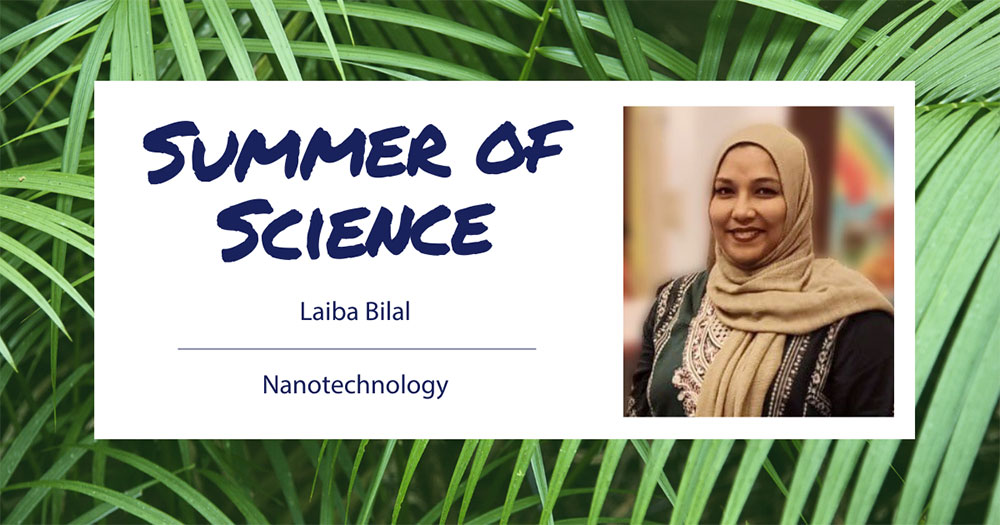Laiba Bilal Uses Nanotechnology to Unlock Clean Energy Sources
August 19, 2022
By Laiba Bilal
The following Q&A was originally published by the Association for Women in Science. Laiba Bilal is a PhD student researcher at the Center for Functional Nanomaterials (CFN), a U.S. Department of Energy (DOE) Office of Science User Facility at DOE’s Brookhaven National Laboratory. Bilal’s research at CFN is supported by Brookhaven’s Laboratory Directed Research and Development funding in collaboration with the Medical Isotope Research and Production Program and the Nuclear Science and Technology Department at Brookhaven. For more information, please contact Stephanie Kossman (skossman@bnl.gov, 631-344-8671).
For #SummerOfScience, AWIS is highlighting members and partners to show the impact different fields of science have on society – and how these fields are impacted by women.
Introduce yourself and your work.
It’s a well known fact that energy is an essential element for industrial and socio-economic development of a country; however, the linkage between energy and its impact has constantly been a challenge. I have always possessed an immense desire to lessen the harsh impacts on the environment, to contribute to steady and affordable resources, and to enhance living standards by being a part of such research.
I initially concentrated my research on renewable energy, focusing on photovoltaic technology, or the conversion of the solar energy into electrical energy. As part of this research, we designed and tested an economical, demonstrative solar photovoltaic system with a reflector that could increase the output. We also knew that cheap, reliable, and easy-to-manage solar energy devices could be extremely useful as teaching aids at institutions and for generating solar power in remote places.
Since the new and highly efficient photovoltaic devices required incorporating nanotechnology to be commercially realized with low-cost fabrication and manufacturing, I became interested in this emerging field of nano.
At present I am a doctoral candidate, completing my research phase at Brookhaven Nation Lab (Center for Functional Nanomaterials), working on nanoparticle synthesis. I mainly focus on silicate nanocages to be tailored for isotope production and nuclear application, and experimenting with trapping noble gases at relevant conditions for intended purposes in nuclear physics and clean energy revolution.
What do you love about this field?
Working at the nanoscale enables scientists to understand and utilize the unique properties of the material that occur at this scale as they can differ significantly from those at larger scales. Nano is the size at which quantum effects can rule the behavior and properties of particles. By modifying the size of the particle, a scientist can literally alter a material’s property of interest. It’s fascinating to study powerful results at quantum, or in a common language, at the atomic/subatomic level of nanomaterials.
How does your work benefit people and society in general?
Solar/photovoltaic power generation has long been seen as a clean energy technology that draws upon the planet’s most plentiful and widely distributed renewable energy source: the sun.
Additionally, trapping of noble gases — either by confinement or separation — has a variety of applications, for example; nuclear waste remediation for a clean environment and Radon detection/removal for lung cancer prevention from buildings.
In short, nanotechnology is helping to considerably improve and even revolutionize many technology and industry sectors: energy/power generation, information technology, homeland security, medicine, transportation, and environmental science, among many others.
What barriers did you have to overcome to get where you are now?
I have worked passionately on clean energy in the field of photovoltaics, I’ve served in academia as a lecturer in a technology institution, and then I started my family, to which I dedicated several years as a homemaker, witnessing my three beautiful girls grow each day. It wasn’t easy to keep the spark alive, but working as a freelancer, tutoring engineering subjects, troubleshooting daily life electronic devices ,and much more helped me overcome the bridge and re-enter my career. Being enthusiastic to be a part of the greatest global transition — the clean energy revolution — I dusted off my skills and prepared myself to return for my Ph.D. at Stony Brook University.
At first it was really challenging to take courses with the fresh graduate students who were fully equipped with current knowledge and technology usage. But my constant hard work, and most of all the support provided by the Department of ECE Stony Brook, paid off. Working under a team of people with such extensive experience enhanced my ways of thinking and problem-solving. The skillsets I learned during this phase led me to a greater facility at Brookhaven Nation Lab.
Why should other women and girls consider studying this field?
The massive increase in population with each passing day brings an infinite number of needs and demands that need to be managed in a meaningful way. Several real-time hazards may be minimized by clean energy.
Science has completely revolutionized the world and its impact on human life, and women have made many commendable contributions, yet women remain underrepresented in many STEM fields. Being a woman in STEM, I would like to encourage other women and girls to break the barrier and step forward as young scientists to take on such interesting challenges.
2022-20779 | INT/EXT | Newsroom










